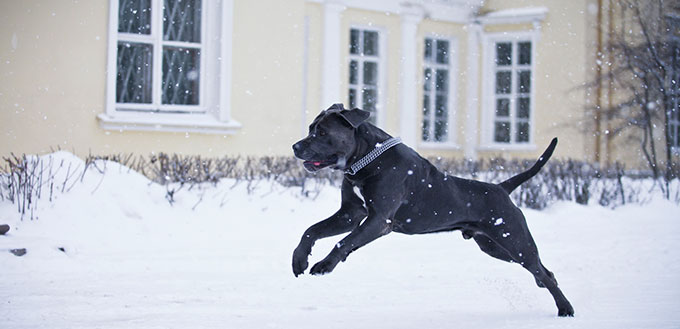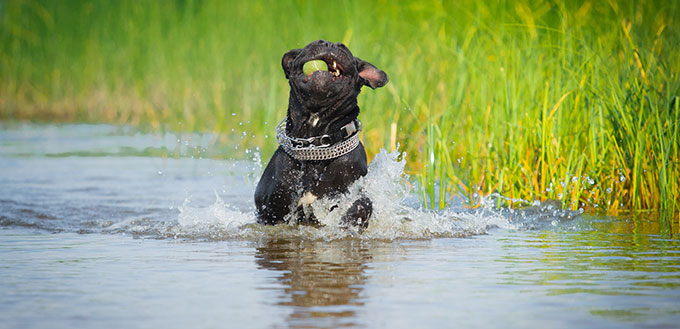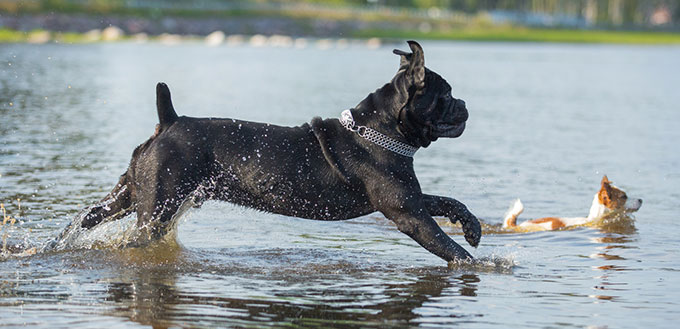Otherwise known as an Italian Mastiff, the Cane Corso (plural, Cani Corsi) holds a regal bearing that goes way back to the 1137 A.D. Mostly known as a guard dog due to its unparalleled devotion and loyalty towards its master, this particular dog breed belongs to the ancient lineage of mollosers with a rather intriguing and protracted history originating from the rule of the Roman empire.
Related Post: Dog Food for Mastiffs
A Brief History & Evolution of the Italian Mastiff: Cane Corso
The Corsi were nurtured and bred by a primitive Greek tribe called the Green Molossi, before the Romans conquered them and took quite a handful of them back to the lands of Italy. The Cane Corso that is so popular among the dog fanatics nowadays, has a blend of the Neapolitan Mastiff and the local Italian dog breed in its bloodline.
During the Roman rule, they often took part in battles and were a major force for the Roman military. This breed has lived up to its fierce and bold reputation since then and were the cause of countless victories on the battlefield.
However, after the prolonged era of the wars were over, the Corsi had to accommodate to the non-military life and were found herding cattle or aiding farmers in their everyday chores from time to time in the Italian countryside.
In order to keep their crops away from trespassers and guard their livestock against wild animals, most of the farmers welcomed a Cane Corso to the family. The Corsi often guarded the livestock on their way to the slaughterhouse because of their dutiful and dominating attitude. They also protected families when they were encountered by a wild animal on the field or at their doorstep and fought for as long as they could hold their breath.
Their popularity and marketability grew very fast and they were a member of almost every other household during that time!
After the end of World War I and World War II, the Corsi were on the edge of becoming gravely extinct. Due to their natural instinct of being loyal to their owners, the Corsi stood by them decisively when the lands were being invaded and hence a lot of them lost their lives during the battle. As most of the men were going to war, a mass number of the Corsi were left behind and killed.
By the time the war was over, Italy had undergone a complete transformation. It wasn’t the same peaceful country anymore and the breed was almost completely lost along with the livestock, barns and buildings. People adopted new ways of protection using guns and other weapons instead of having a guard dog like Cane Corso to protect them. They also modified their barns into machine-like frames that no longer required the protection of a Corso or any other guard dog for that matter.
However, in the 1970s, a group of researchers and Corsi admirers set out on a mission to find what was left of these faithful and ferocious species in the Italian countryside. They were in luck since they found a few of them and bred them with other species afterward. Later in the 1980s, the Corsi became widely popular not only in all of Europe but also in the United States and now stands 40th on the list of the most favored dog breeds all over the world.

Some Quick Facts about the Corsi:
- With ‘canis’ being ‘dog’ and ‘cohors’ being ‘bodyguard,’ the name Cane Corso means ‘bodyguard dog’ in Latin.
- Their fur needs proper grooming every week and it sheds in excessive amounts twice a year.
- Due to its aggressive nature, the Corsi are not a good option for amateur families or the ones who are adopting dogs for the first time.
- You can never misbehave with a Corsi because they do not take ill-treatments well. If you need them to go by the rules of the house, you need to have the patience to train them for as long as it takes. It is better to adopt a newborn since they need time to be properly groomed and trained to prevent them from being violent to strangers afterward.
- It has a lifespan of about 10-12 years.
- Corsi are more appropriate for families who have a huge backyard since they are huge in size and require a lot of physical activities.
- They are more susceptible to optical illnesses and dysplasia.
- Corsi can exercise vigorously twice a day and can even catch up to you while you’re riding a bike.
- The Corsi were showcased at European Dog Shows from the early 1990s.
- Its weight varies from 90-120 pounds.
- Experts advise not to keep Corsi alone at home as it can get very lonely and you can’t ask someone else to look after them while you’re gone because they are never really intrigued by outsiders.
- It is essential to keep your dog active, both physically and mentally so that they do not get exhausted and bored of civilian. You’ll know when they are just done putting up with you when they dig up big holes in the yard, chew furniture or bark at strangers.
- If not trained properly, the breed can be dangerous to other small pets in the neighborhood.
- The Corsi was acknowledged by the American Kennel Club in the year 2010.
- It was acknowledged by the World Canine Organization in the year 2007.

Training
Training a Corsi isn’t always an easy task unless you plan on welcoming a newborn or a three-twelve weeks old puppy into the family. Puppies and newborns are usually easier to train since they have a lot of time to get accustomed to the rules of the house and are very cooperative.
Besides, training gets a lot easier when you have developed some sort of understanding with the puppy. A form of communication will build a solid trust and he/she will hence listen to your command.
Obligate yourself and the others to use a more sanguine or positive approach while training them. Your pup will soon comprehend that a ‘no’ means it’s highly ‘off limits.’ This means that you won’t have to stress or shout at them to bring about positive changes in their behavior. It is important that they receive the same kind of command and training from all other members of the family. Otherwise, their training would bear no fruit as they will get confused while keeping up with various commands.
While training, refrain yourself and others from overindulging them just because they’re new to the family or because you think it is okay to give in to their demands once in a while. At no cost should you let them jump on the furniture, bite shoes, couch covers or other materials as this may lead them to believe that this sort of behavior is acceptable.
It is recommended that you start with the very basic commands like “sit”, “heel” or “stay” and delve into the harder commands later on. If need be, use treats to make them listen, even though mostly a firm command is all that you will need to make them listen to you. Guide them through their training and give the dog a chance to interact with strangers or other pets on walks or runs.
While meeting new people on walks, allow them to play with your pup and offer them a pet treat, each time they meet someone new. This will make sure that they are sociable and amicable towards other people or pets they are not acquainted with from a very young age. Pretty often owners fail to do this and as a result, their dogs show aggression towards those who they are unfamiliar with which is common in their nature.
Unfortunately, the work doesn’t end there – you must familiarize them with their surroundings as well. If not, your pup may prove to be difficult and timid; even the usual daily tasks will end up becoming tougher for you. Treat them like the adult dogs and take them on errands instead of keeping them confined within the boundaries of your home and garden which will only lead to the development of characteristic aggressiveness and unneeded shyness.
However, unlike a puppy, an adult Cane Corso will prove to be more difficult to deal with. So if you’ve adopted one already past its young age, you will have to put quite an effort in order to tame it. But training principles for pups and adults remain the same. Some problems you are sure to face are:
- Excessive barking
- Biting
- Food aggression
- Jumping on people
Excessive Barking
While barks sure keep owners aware and safe, intemperate barking is quite annoying to deal with. If you see your Cane Corso barking excessively when you return home, do not encourage them by addressing them immediately. If the same occurs when telephones or bells ring, do not make a motion to stop the sound.
Alternatively, use commands like “quiet” or “hush” when they keep on barking continuously. If that doesn’t work then train them to tolerate the sound and make them get used to it by ringing bells or telephones continuously. This will reduce their excitement by ten folds and hopefully stop the barking. It may help to recompense them when they successfully respond to your command.
Related Post: Best Apps to Stop Dog Barking
Biting
Some adult Cane Corso will show errant behavior every once in a while and try to bite while playing or otherwise. That is where you step in as a parent. A firm “no!” should really be enough but if not, give them a chew toy instead. If the biting doesn’t stop, then you must withdraw from them immediately. It’ll establish that their behavior is intolerable and you disapprove of it. Not only will it dishearten them but also stop the biting.
Related Post: Chew Toys for Puppies
Food Aggression
Another wayward behavior they might demonstrate is dog food aggression. This is where they’ll become defensive of their food and will try to ward you off if you interfere in between meals. In such cases offer them empty bowls and gradually fill them up when you choose to do so. Then they know you are the one in authority to give them food. A different technique that you could also try is to put occasional treats during meals which will let them know that you mean no harm.
Jumping
Having an adult Cane Corso jumping around you while greeting them can be quite unlikeable after they’ve grown out of their childhood. Most often it becomes a frightening situation as they show excessive excitement.
So in order to dampen their over-excitement, show less eagerness yourself. Angle yourself away from him and his paws and he’ll get the message that his behavior isn’t as pleasing and would not be tempted to repeat.
However, the main key to training is communication. The better the understanding you create between the both of you, the easier it will be to train your Corsi.

Temperament & Personality
The Cane Corso has had a reputation of being an all-purpose dog since the beginning of its history. Its transformation over the years has made it a suitable breed for being the perfect guard dog for people. However, their behavioral traits differ when there is a sudden change in the surrounding.
When among family or friends who they are very much familiar with, the Corsi loves to please their masters. They are calm, poised and always ready to enjoy a peaceful evening among his/her favorite humans. However, if encountered by an invader or an unknown threat, it switches into its defense mode right away and protects their master from the slightest danger that lurks around.
Even though they have proved to be a very loyal and fierce companion, a certain trait of theirs is that they are quite dominating and it’s necessary to remind them from time to time about who is in charge as they like to be a bit imperious.
If trained properly, they cooperate and abide by the rules at all times maintaining a friendly and healthy atmosphere inside the house. However, the training must be under friendly yet strict supervision which will ensure that they will listen to your command and not show aggressive behavior.
Exercise
Formerly used as a member of the military force and a guard dog for hunting and protecting livestock, the Corsi are capable of keeping themselves fit and in shape on their own. Their random strolls around the house and occasional walks or runs are just about enough to keep them strong and sturdy. Hence you won’t need to put much effort worrying or stressing out about your Corso being overweight or underweight. However, a balanced diet will also ensure their physical fitness.
Feeding
Like any other dog breed, Cane Corso needs to have a balanced diet comprising of all the elements necessary for their health and growth. Since these Italian mastiffs are very energetic it is common for them to require more food than most other family dogs. But most essentially their food requirement will depend on their physique.
Weighing between 100-125 pounds, each week these dogs require 5 to 10 pounds of kibble. Depending on the size of your Cane Corso, he/she will ingest 4-8 cups of kibble twice a day.
Related Post: Best Dog Food for Cane Corso
As mentioned before his food intake will depend on the age, size, metabolism, physique and energy level. Dog food from high-end brands will ensure that they are receiving enough nutrition and nourishment and you will also save up on the food since a little will go a long way to keep your pup energetic and healthy.
However, you do need to make sure that you keep a stable balance of all the elements in his diet. Even though these dogs mostly like to eat kibble, do not forget to make fats, carbohydrates, proteins, vitamins and minerals a part of their regular diet.
Related Post: Best Dry Dog Food
Bottom Line
Like any other dog breed, the Corsi can also be racked with pain when parted from its loved ones. Though famous for its ferocious nature as a war dog, the Italian Mastiff holds an unparalleled sense of undying love and everlasting loyalty for their owners. So, do not think twice before adopting a Corso if you are well experienced and prepared for the commitment. They will always stand by you and protect you till they take off their last breath.
You may also like our article: Presa Canario vs. Cane Corso – Comparing Two Similar Breeds
Sources:
- Cane Corso, PetMD
- Cane Corso, VetStreet






